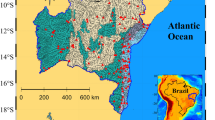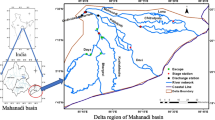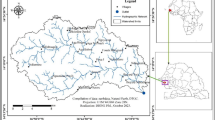Abstract
The study focuses on climate change impacts on the environmental flow indicators from hydrologic method point of view using IWMI’s Global Environmental Flow Calculator and Indicators of Hydrologic Alteration. It also discusses how the changes in flow magnitude and duration of annual extreme conditions, timing of annual extreme water condition, frequency and duration of high and low pulses, rate and frequency of water condition changes will affect the ecosystem. Climate change disturbs the ecology by directly affecting the functions of individual organisms (growth and behavior), modifying the population (size and age structure), and altering the ecosystem structure, functioning (e.g., decomposition, nutrient cycling, water flows, and species composition and species interactions) and its distribution within landscapes (Gitay et al., 2002). Ecosystem regime shifts can occur naturally and by anthropogenic factors (Muenich et al. in Ecol Model 340:116–125, 2016). Climate change effects on flow regime are expressed by different indicators such as mean annual runoff, mean river discharge, low and high flows, mean seasonal discharge, and changes from permanent to intermittent flow or vice versa. Understanding of changes in flow regimes is important for the well-being of humans and freshwater-dependent biota with respect to water and habitat availability (Döll and Schmied in Environ Res Lett 7(1):14037, 2012). Even though the basin is rich in fish species, peoples living in lower Omo-Gibe basin and Turkana region are undertaking a traditional fishing culture. Wildlife in the parks, pastoralist communities using the flood recession farming and livestock farming are dependent on the river. The environmental flow that sustains these activities is inevitably necessary for the survival of the biodiversity. Understanding of the flow variability helps to protect the freshwater biodiversity and maintenance of goods and services that the river provides.

























Similar content being viewed by others
Availability of data and materials
The datasets analyzed during this study are not publicly available due to data restriction. The data and results in this manuscript are part of a PhD thesis of the first author.
References
Avery S (2014) What future for Lake Turkana and its wildlife. SWARA, Jan–Mar
Ayalew L (2009) Analyzing the effects of historical and recent floods on channel pattern and the environment in the Lower Omo basin of Ethiopia using satellite images and GIS. Environ Geol 58(8):1713–1726
Carr CJ (1998) Patterns of vegetation along the Omo River in southwest Ethiopia. Plant Ecol 135(2):135–163
Davis R, Hirji R (2003) Water resources and environment technical note c1, environmental flows: concepts and methods. The World Bank, Washington
Döll P, Schmied HM (2012) How is the impact of climate change on river flow regimes related to the impact on mean annual runoff? A global-scale analysis. Environ Res Lett 7(1):14037
Döll P, Zhang J (2010) Impact of climate change on freshwater ecosystems: a global-scale analysis of ecologically relevant river flow alterations. Hydrol Earth Syst Sci 14(5):783–799
Dyson M, Bergkamp G, Scanlon J (2003) Flow: the essentials of environmental flows. IUCN, Gland, Switzerland and Cambridge, UK, pp 20–87
Gao Y, Vogel RM, Kroll CN, Poff NL, Olden JD (2009) Development of representative indicators of hydrologic alteration. J Hydrol 374(1–2):136–147
Gitay H, Suárez A, Watson RT, Dokken DJ (2002) Climate change and biodiversity Intergovernmental Panel on Climate Change. Switzerland, Geneva
Golubtsov AS, Mina MV (2003) Fish species diversity in the main drainage systems of Ethiopia: current state of knowledge and research perspectives. Ethiop J Nat Resour 5(2):281–318
Gopal B (2013) Methodologies for the assessment of environmental flows. In: Environmental flows: an introduction for water resources managers, pp 129–182
Hill MT, Platts WS, Beschta RL (1991) Ecological and geomorphological concepts for instream and out-of-channel flow requirements. Rivers 2(3):198–210
Hirpo LA (2017) Fisheries production system scenario in Ethiopia. Int J Fish Aquatic Stud 5(1):79–84
Karimi SS, Yasi M, Eslamian S (2012) Use of hydrological methods for assessment of environmental flow in a river reach. Int J Environ Sci Technol 9(3):549–558
Laizé CLR, Acreman MC, Schneider C, Dunbar MJ, Houghton Carr HA, Flörke M, Hannah DM (2014) Projected flow alteration and ecological risk for pan-European rivers. River Res Appl 30(3):299–314
Mazvimav D, Madamombe E, Makurira H (2007) Assessment of environmental flow requirements for river basin planning in Zimbabwe. Phys Chem Earth Parts A/B/C 32(15–18):995–1006
Mittal N, Bhave AG, Mishra A, Singh R (2016) Impact of human intervention and climate change on natural flow regime. Water Resour Manag 30(2):685–699
Muenich RL, Chaubey I, Pyron M (2016) Evaluating potential water quality drivers of a fish regime shift in the Wabash River using the SWAT model. Ecol Model 340:116–125
Pastor AV, Ludwig F, Biemans H, Hoff H, Kabat P (2014) Accounting for environmental flow requirements in global water assessments. Hydrol Earth Syst Sci 18(12):5041–5059
Piniewski M, Laizé CLR, Acreman MC, Okruszko T, Schneider C (2014) Effect of climate change on environmental flow indicators in the Narew Basin, Poland. J Environ Qual 43(1):155–167
Poff NL, Allan JD, Bain MB, Karr JR, Prestegaard KL, Richter BD, Stromberg JC (1997) The natural flow regime. Bioscience 47(11):769–784
Poff NL, Richter BD, Arthington AH, Bunn SE, Naiman RJ, Kendy E, Freeman MC (2010) The ecological limits of hydrologic alteration (ELOHA): a new framework for develo** regional environmental flow standards. Freshw Biol 55(1):147–170
Reitberger B, McCartney M (2011) Concepts of environmental flow assessment and challenges in the Blue Nile Basin, Ethiopia. In: Nile river basin. Springer, pp 337–358
Richter B, Baumgartner J, Wigington R, Braun D (1997) How much water does a river need? Freshw Biol 37(1):231–249
Richter BD, Baumgartner JV, Braun DP, Powell J (1998) A spatial assessment of hydrologic alteration within a river network. Regul Rivers Res Manag Int J Devoted River Res Manag 14(4):329–340
Smakhtin VU, Anputhas M (2006) An assessment of EF requirements of Indian river basins. Research report 107, International Water Management Institute, Colombo, Sri Lanka
Tesfaye G, Wolff M (2014) The state of inland fisheries in Ethiopia: a synopsis with updated estimates of potential yield. Ecohydrol Hydrobiol 14(3):200–219
Tesfaye TW, Dhanya CT, Gosain AK (2017) Evaluation of ERA-Interim, MERRA, NCEP-DOE R2 and CFSR Reanalysis precipitation Data using Gauge Observation over Ethiopia for a period of 33 years. AIMS Environ Sci 4(4):596–620
Thompson JR, Laizé CLR, Green AJ, Acreman MC, Kingston DG (2014) Climate change uncertainty in environmental flows for the Mekong River. Hydrol Sci J 59(3–4):935–954
Vogel RM, Sieber J, Archfield SA, Smith MP, Apse CD, Huber Lee A (2007) Relations among storage, yield, and instream flow. Water Resour Res. https://doi.org/10.1029/2006WR005226
Vörösmarty CJ, McIntyre PB, Gessner MO, Dudgeon D, Prusevich A, Green P, Liermann CR (2010) Global threats to human water security and river biodiversity. Nature 467(7315):555
Wakjira M, Getahun A (2017) Ichthyofaunal diversity of the Omo-Turkana basin, East Africa, with specific reference to fish diversity within the limits of Ethiopian waters. Check List 13(2):2059
Zolezzi G, Bellin A, Bruno MC, Maiolini B, Siviglia A (2009) Assessing hydrological alterations at multiple temporal scales: Adige River, Italy. Water Res. https://doi.org/10.1029/2008WR007266
Acknowledgements
The authors would like to acknowledge the following organizations for providing the datasets: Ministry of Water, Irrigation and Electricity of Ethiopia for providing streamflow, National Metrologic Agency of Ethiopia for synoptic station precipitation and surface temperature data; and CORDEX Africa and NASA for CHIRPS and UGCPC datasets.
Funding
The Federal Democratic Republic of Ethiopia Ministry of Education and now named as the Ministry of Science and Higher Education in collaboration with IITD.
Author information
Authors and Affiliations
Contributions
TWT performed the modeling and drafted the manuscript; CTD and AKQ Gosain conceptualized the idea and analyzed the results.
Corresponding author
Ethics declarations
Conflict of interest
The authors declare that they have no conflict of interests.
Additional information
Publisher's Note
Springer Nature remains neutral with regard to jurisdictional claims in published maps and institutional affiliations.
Rights and permissions
About this article
Cite this article
Tesfaye, T.W., Dhanya, C.T. & Gosain, A.K. Modeling the impact of climate change on the environmental flow indicators over Omo-Gibe basin, Ethiopia. Model. Earth Syst. Environ. 6, 2063–2089 (2020). https://doi.org/10.1007/s40808-020-00813-x
Received:
Accepted:
Published:
Issue Date:
DOI: https://doi.org/10.1007/s40808-020-00813-x




